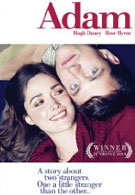There’s nothing more unpleasant than a person who is completely self-centered. They talk and talk about everything and anything happening in their lives, and even if you manage to squeeze in a tidbit about yourself, it goes unnoticed. But what happens when someone really can’t help being totally self-absorbed? Even worse, what about a person who is practically incapable of comprehending what another is feeling? Adam explores what happens when an average woman falls for a man with just such a problem, while also keeping the audience’s needs a top priority and creating a film that is self-aware and eager to please. After his father passes away, Adam (Hugh Dancy) lives alone in their New York City apartment. The place is immaculate, his freezer stocked with macaroni-and-cheese dinners, cupboard filled with Fiber Brand cereal, and his brain wracked with extensive knowledge of astronomy. Rather than use his good luck and subtle charms on his new neighbor, Beth (Rose Byrne), he barrages her with a tremendously complicated dose of information about space. She’s intrigued, but Adam’s strange behavior can be rather off-putting. It isn’t until Adam admits that he has Asperger’s syndrome that things begin to make sense and the two develop an unlikely relationship.
Dancy combines a stellar performance with his natural appeal to create a complex yet very likeable character. The condition makes social interaction extremely difficult for Adam and reduces his range of interests to a handful of obsessions. Additionally, he is incapable of reading and understanding other’s emotions. Rather than letting Asperger’s syndrome consume the character, Dancy makes Adam such a strong individual that the disorder fades into the background. It’s always there but never overwhelmingly so.
Byrne, on the other hand, can be overwhelming at times. She begins as an extremely upbeat young woman that just smiles and giggles at all of Adam’s idiosyncrasies. Once she descends from la-la land and is forced to recognize Adam’s condition and deal with her own troubles, Beth becomes a real and effective character. When the two developments collide, she really excels. Beth’s father (Peter Gallagher), with whom she is very close, is being indicted and could go to prison. She’s terribly distraught about the thought of daddy doing time behind bars and struggles with the fact that Adam cannot understand what she’s feeling.
If it wasn’t for this added tension, the subplot about the trial would be completely superfluous. Adam moves at the perfect pace except during the moments that the focus shifts to exploring the details of Mr. Buchwald’s transgressions. The relationship between Beth and her father feels more like a poorly developed made-for-TV sob story, whereas the one between her and Adam is powerfully authentic.
With the help of a congenially appropriate soundtrack and beautiful scenic shots of Manhattan, particularly Central Park, writer/director Max Mayer combines a mild dose of humor with the distress of an unfortunate condition to create something extremely endearing. Adam is about a man struggling with Asperger’s syndrome, but more so about a man struggling to develop a relationship with a woman. Regardless of the characteristics of the condition, the connection between Adam and Beth is similar to any other individuals in the midst of a budding romance. The details and roadblocks may differ, but the overall sense of authenticity allows anyone to identify with their situation. It’s interesting to hear Mayer reliving his thought process, but it’s not enough to justify rewatching the entire film with the commentary. The best material is the discussion of the details of Asperger’s syndrome and how he attempts to portray it on film. Clearly, this is the most powerful aspect of the film and deserves its own featurette rather than a few mentions in the commentary. Producer Leslie Urdang doesn’t have much to offer except breaking up Mayer’s monotone delivery.
The alternate ending was used when the film first premiered at the Sundance Film Festival last year. Like most alternate endings, it’s far less effective than the final version. This is a good piece to give two viewings: one without the commentary and then with the director’s thoughts. He’s aware the final version is the winner, but elaborates on the benefits of his initial idea of keeping the conclusion more concise. When it comes to the deleted scenes, just one viewing will suffice: with the commentary. They’re clearly expendable moments and only become interesting when viewed with Mayer’s remarks.
"Creating Adam" is simple and sweet, just like the film. The only problem is there’s no making-of material. It’s just a sequence of clips connected by interviews with Dancy and Byrne talking about developing their characters. Granted, the most pressing issue of making Adam is creating a character who properly portrays a man with Aspberger’s, but some behind-the-scenes footage would have been appreciated.
Your Daily Blend of Entertainment News
The segment from Fox Movie Channel’s Life After Film School sees a trio of film students sit down with Byrne and probe her on her experience working on the film. The interview is very rigid, but by the end the students are more laid back and start to have a conversation with Byrne rather than a seemingly scripted formal interview.
Overall, you’re not buying Adam for the bonus material. You’re better off watching the film again rather than wasting time surfing the special-features menu. It’s a shame, because Adam is the type of movie you crave more of after it’s over. The disc could have been fantastic if paired with a proper making-of featurette or a more in-depth interview with Dancy exploring how he approached his role.
Staff Writer for CinemaBlend.


